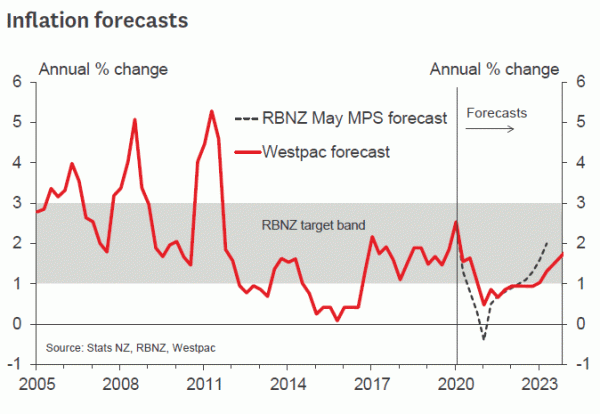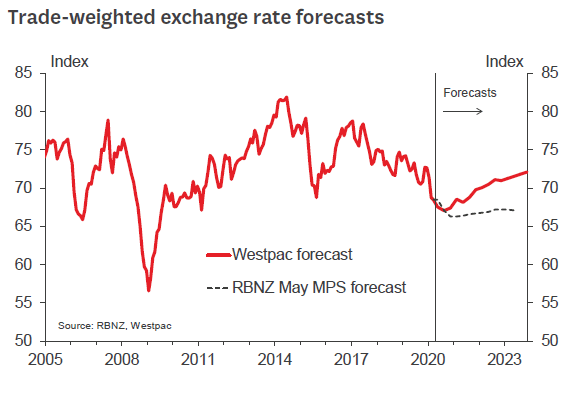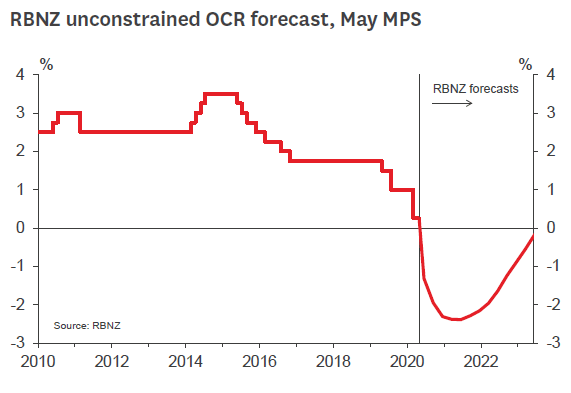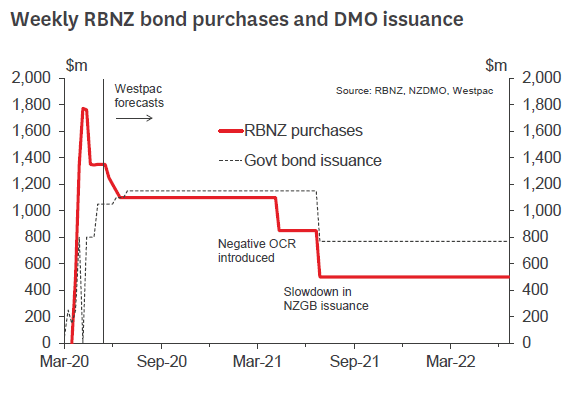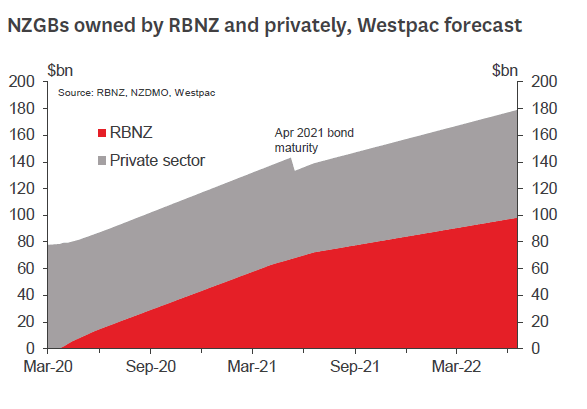- We now expect the RBNZ will reduce the OCR to -0.5% in April 2021 (previously November 2020).
- We expect that the RBNZ will expand its Large Scale Asset Purchase (LSAP) programme to $70bn at the June OCR Review, and $80bn at the August MPS.
- We forecast that the weekly pace of LSAP bond purchases will average $1.1bn until April 2021, slowing to $0.8bn after a negative OCR is introduced.
- We calculate that the LSAP will eventually total $100bn by June 2022.
- We are not forecasting foreign bond purchases, but if there is another big negative economic shock this year then the RBNZ could use that option
On 28th April we predicted that the OCR would drop to -0.5% in November. However, we were always uncertain of the timing, which we recognised would depend on how long it takes for trading banks to become operationally ready for a negative OCR. We were also uncertain about how the RBNZ would treat its March 2020 statement that it did not intend to change the OCR for a year – was that guidance, which can change, or a promise?
The combination of last week’s RBNZ Monetary Policy Statement (MPS) and a swathe of RBNZ media interviews over the past couple of days has provided definitive answers to both questions.
The Reserve Bank revealed that it has asked the trading banks to ready themselves to implement a negative OCR by December 1 this year. That means a negative OCR will be operationally possible from the start of 2021.
Regarding the commitment not to change the OCR, the RBNZ’s official statement at the MPS talked only about “guidance”. Guidance is a much softer term than commitment, allowing flexibility as circumstances change. Deputy Governor Geoff Bascand has subsequently come out with far more definitive language in a media interview:
“We stick to our commitment. We are keeping the OCR on hold for a year.
“We are very conscious that our word matters and the credibility of what we say is very important to the Reserve Bank.
“We are confident we won’t be moving to negative interest rates before March next year.”
That is the kind of cross-my-heart-and-hope-to-die language we needed to hear from the RBNZ to be sure that it wouldn’t move before March 2021, given that we expect the banks will be operationally ready and there will be an obvious need for a lower OCR before that date.
Accordingly, we are now changing our forecast. We now expect that the RBNZ will cut the OCR to -0.5% in April 2021. (There isn’t a scheduled OCR review in March.) Our call for a negative OCR is based on:
(1) Our assessment that inflation will be unacceptably low unless substantial monetary stimulus is delivered over an extended period (as explained in the next section); and
(2) Our assessment that the RBNZ’s Large Scale Asset Purchase (LSAP) programme cannot deliver the required stimulus for the required length of time (explained in the final section).
Much more stimulus is needed… depending on the exchange rate.
The coming recession is going to cause very low inflation. Our inflation forecast is at or below 1% until 2023 even after we have accounted for the Government’s massive spending package, a negative OCR, and an expansion of the RBNZ’s bond buying programme beyond what has already been announced. Without these additional RBNZ measures, our inflation forecast would be even lower.
The Reserve Bank’s forecast is that a $60bn LSAP will be enough to return inflation to 2% by 2023. But that is based on an assumption that the exchange rate will fall further from here, and that it will stay low for years. We find that assumption unrealistic. Without negative interest rates or an expansion to the LSAP, we think the exchange rate is more likely to rise over time, for a number of reasons:
- The NZD/USD is currently well below its long-run inflationadjusted average.
- The NZD tends to rise when global risk sentiment improves. We expect risk sentiment will indeed improve as the Covid crisis fades over a number of years.
- New Zealand has fared well in the face of Covid, and has a very strong fiscal position compared to many countries.
Our exchange rate forecast is higher than the RBNZ’s, even though we expect OCR cuts and a bigger LSAP than the RBNZ is forecasting. This is the key reason that we think an expansion to the LSAP and a negative OCR will be required.
A forecast of the RBNZ’s bond buying programme.
With a negative OCR unavailable until March next year, the RBNZ is going to have to rely on its LSAP programme of Government Bond buying in the meantime. The governance process is that the Monetary Policy Committee announces a total cap on the LSAP for the coming year – $60bn at present. But this cap is not particularly relevant. It is the weekly pace of purchases, relative to the pace of bond issuance, that actually determines the impact of the LSAP on interest rates and the economy. That weekly pace is decided by the RBNZ staff. As we understand it, they have been given instructions to keep interest rates very low.
From today, we will be formally forecasting the weekly pace of RBNZ bond purchases, as well as the cap on purchases announced by the MPC. Our first set of forecasts is set out in the table on page 4.
The RBNZ will be aiming to buy enough bonds to provide sufficient monetary stimulus, while not buying so many that liquidity in the rest of the bond market dries up.
The RBNZ’s models show that in order to meet its inflation and employment targets, it needs to deliver monetary stimulus equivalent to an OCR of -2% over a period of two years. We broadly agree with that. The required monetary stimulus could be delivered by cutting the OCR itself, or by buying Government Bonds in the LSAP.
Recently, the RBNZ has been buying $1.35bn of bonds per week. That pace has been sufficient to deliver monetary stimulus equivalent to an OCR of -2%.1 However, this pace cannot be sustained without impairing market liquidity – by February the value of bonds held in the rest of the market would have fallen from $73bn to $64bn, and the $60bn cap will have been exhausted.
There may be some scope for the RBNZ to slow the weekly pace of purchases while still keeping interest rates low, as markets continue to calm over the coming months. We are forecasting an average weekly purchase pace of $1.1bn later this year. However, even at that pace the LSAP would soon run out of headroom.
Therefore, we conclude that the RBNZ is going to have to change the mix of monetary policy tools its using early next year. It could lower the OCR to -0.5% and at the same time slow the pace of bond purchases to roughly $800m per week. This would continue to deliver monetary stimulus equivalent to an OCR of -2%, without exhausting the scope of the LSAP.
The Government’s Debt Management Office (DMO) has indicated that it will issue $60bn worth of bonds in the fiscal year ending June 2021, but it will slow the pace of issuance to $40bn for the year ending June 2022. At that time the RBNZ could slow the pace of its purchases to $500m per week while still keeping interest rates low, providing that a negative OCR was helping out.
In total, we expect the LSAP will amount to $100bn by June 2022. However, the MPC need not announce that immediately. If they stick to announcing only what is required for the following twelve months, then we would expect the LSAP to be expanded to $70bn at the June OCR Review, to $80bn at the August MPS, and for further gradual expansions to occur later.
The RBNZ has previously stated that it would be comfortable owning up to half of all bonds outstanding, and the Government has indemnified the RBNZ for this amount. However, we do not believe that these are binding constraints, as they could be altered at the stroke of a pen. The truly binding constraint is the requirement to keep the bond market liquid. We think that means ensuring that the total face value of bonds not owned by the central bank remains close to $70bn, which was roughly the size of the bond market before Covid struck. Our LSAP forecasts are carefully designed to respect this binding constraint.
What about foreign bond purchases?
The RBNZ has recently stated that if further monetary stimulus is required in the future, it could opt for a negative OCR (if possible at the time), expand the LSAP to purchase more NZ Government Bonds (if liquidity considerations allow), or expand the LSAP to include purchasing foreign bonds.
Purchasing foreign bonds is also known as unsterilised exchange rate intervention. The central bank “printing” New Zealand dollars and exchanging them for foreigncurrency denominated assets tends to reduce the exchange rate, which in turn prompts higher inflation.
We think this would be the least preferred of the three options listed above. It is best suited to a scenario in which the exchange rate is unhelpfully high. Using exchange rate intervention when the exchange rate is already below average smacks of a solution in need of a problem. It also risks the RBNZ losing money if the exchange rate later rises toward its long run average.
However, if exchange rate intervention was the only option available then the RBNZ would use it. At this stage we are not forecasting the use of foreign bond purchases, but if there is a serious negative economic shock later this year (such as a second wave of Covid), and neither a negative OCR nor expanding the LSAP is an option, then foreign bond purchases could become a reality.
Last but not least… fiscal policy.
All of our analysis assumes that the DMO sticks to its issuance plans of $60bn in the 2020/21 fiscal year, and $40bn in 2021/22. One obvious risk is that the Government could end up expanding fiscal policy further, meaning the DMO would need to issue even more bonds. However, we don’t consider this as an especially acute risk. A sizable chunk of the Government’s fiscal stimulus package is infrastructure and house building. Money tends to flow out the door more slowly than forecast when construction projects are inevitably delayed, and that reduces the need to borrow. Also, the Government still has $20bn from its Covid fighting fund to allocate before it considers expanding its fiscal stimulus even further




